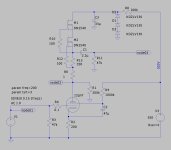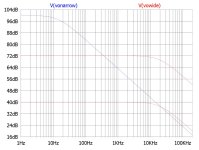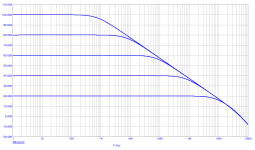Wondering if the tests were conducted to professional standards such as those described in: https://www.itu.int/dms_pubrec/itu-r/rec/bs/R-REC-BS.1116-3-201502-I!!PDF-E.pdf...results of DBT tests.
Another way to state that is "don't try to turn a 100dB open-loop gain amplifier into 50dB". 🙂People often focus on the OL gain starting to roll of at say 10Hz, and that frightens them - how can an audio amp be any good with a roll off at 10Hz??
They go as far as to resistively load the Vas stage to squash the OL gain until it is as low everywhere as at 20kHz, thereby ruining the linearity below 20kHz.
Yet, when you grok the situation it isn't frightening at all.
Ed
People often focus on the OL gain starting to roll of at say 10Hz, and that frightens them - how can an audio amp be any good with a roll off at 10Hz??
Jan
People accept dogma without question, and reject facts. Objectivity is the exception in the human species.
I'm really sick of arguing with stupid people. In "real life" (away from the internet) I only know two people that have the faintest clue about scientific facts.
I'm thinking folklore.It has been argued that the difference between a power amp with 0.1% and 0.01% can be heard even with speakers that distort 3%.
I don't know how solid that is though. May be folklore.
Jan
Feedforward can blow up on you sometime.I have been in a situation where I demo'd a feedforward amp to a friend and then noticed that one of the (wideband) speakers stopped working and turned out to be open voicecoil.
Fortunately, the speaker dealer was nearby, so we got a new driver, mounted it and all was well. For 5 minutes, when it stopped working again. Open circuit driver. That's when I got that sinking feeling in my stomach.
Jan
Good THD and IMD IMV just reflect good engineering - but as a primary measure of amplifier performance they fall far short of describing how an amplifier fares in the real world and represent just one of 7 or 8 important parameters.
Professional scientists don't always agree as to whether science produces "facts."...the faintest clue about scientific facts.
https://undsci.berkeley.edu/underst...only disprove,by new evidence or perspectives.
https://blogs.scientificamerican.com/mind-guest-blog/im-a-scientist-and-i-dont-believe-in-facts/
https://www.newscientist.com/lastword/mg25233662-400-when-does-a-theory-become-a-fact-and-who-decides/#:~:text=So in reality, in science,accepted theory at the time.
That goes without saying.
It does not negate the FACT that the world is full of sophistry. Audio is especially full of sophistry.
It does not negate the FACT that the world is full of sophistry. Audio is especially full of sophistry.
Sophistry coupled with the intention to deceive can be considered lying. Advertising copy is expected to be prejudicial, either by presenting data that is misleading by way of exclusion of material prejudicial against the product, or presented in a way supporting a desired faulty conclusion not following from the premises. Copy that seems invariably sent to lawyers to support plausible deniability.That goes without saying.
It does not negate the FACT that the world is full of sophistry. Audio is especially full of sophistry.
The term "sophistry" seems too strong a term to be generally used to describe members here, although it is remarkable the extent many don't seem to recognize even basic fallacious arguments. I don't hold that against them because I am no expert. All that I expect is honesty. However, being truthful is something I have struggled with in the past, particularly when my daughter was still young.
This was at a time when she was too old to keep believing in Santa Claus, defending herself in public suggesting that daddy wouldn't lie to her about this! Being opposed to letting her embarrass herself further I had to apologize and confess that her precious daddy was a lying scumbag. I then suggested that she go tell her little brother, to do what she said, or otherwise she would send Santa a letter falsifying the claim that he was a rotten little scoundrel and Santa wouldn't give him any more presents. I also suggested that she hug the little tike, tell him that life isn't fair and that daddy was supporting her and gave her some stamps.
Okay... maybe the "little tike" is lucky that he never existed... though I miss him already...
Last edited:
From the article: "The conclusion must be that for highest distortion reduction in the audio band, a narrow open-loop very high gain frequency response that starts to roll off at a relatively low frequency is to be preferred over a lower gain flat open loop response, if both have the same open-loop gain at 20kHz."
The article addresses a single limited case of two alternatives with asymptotic gain/bandwidth roll offs. Consider instead the top red line in the edited open loop graph below. With feedback bringing both to the 40 dB gain of the bottom red trace the blue line's reduced available gain above ~350 Hz suggests inferior distortion performance to the wider bandwidth top red trace where it matters most. Momentarily leaving aside questions of audibility, isn't this the usual goal of wide open loop bandwidth?
Gain coupled with bandwidth is achievable. On the bench the circuit below passes a good 10 kHz square wave with a gain over 300. As written the conclusion can be taken to imply narrow bandwidth is a better design target as a matter of course.
The article addresses a single limited case of two alternatives with asymptotic gain/bandwidth roll offs. Consider instead the top red line in the edited open loop graph below. With feedback bringing both to the 40 dB gain of the bottom red trace the blue line's reduced available gain above ~350 Hz suggests inferior distortion performance to the wider bandwidth top red trace where it matters most. Momentarily leaving aside questions of audibility, isn't this the usual goal of wide open loop bandwidth?
Gain coupled with bandwidth is achievable. On the bench the circuit below passes a good 10 kHz square wave with a gain over 300. As written the conclusion can be taken to imply narrow bandwidth is a better design target as a matter of course.
Attachments
You have replaced one of the opamps, which originally have the same gain-bandwidth-product, with an amp that has a higher GBW.
If you do that, I want to use that same (op)amp also in the other case, and we're back to square one.
I specifically selected opamps with the same GBW to ensure valid comparison of like to like.
Jan
If you do that, I want to use that same (op)amp also in the other case, and we're back to square one.
I specifically selected opamps with the same GBW to ensure valid comparison of like to like.
Jan
"Figure 1 shows an instance of the two cases, while Figure 2 shows the two open-loop curves, graphed with R3 and R6 from Figure 1 removed."
Wasn't that the point?
Wasn't that the point?
I am just a stupid mechanical guy.
But I'll just expose my stupidity once in the public.
Let's say I have 2 amplifiers with the same closed loop gain and distortion at 1kHz.
Amplifier 1 has an open loop bandwidth of 10Hz.
Amplifier 2 has an open loop bandwidth of 20kHz.
At 100Hz, amplifier 1 sure wins, not because it is more linear, but because it has more NFB.
But what happens at 10 kHz ?
The question is of course, am I more interested in distortion at 100Hz, or 10 kHz.
This is a line amp by Akihito Kaneda known as the No.168 :
https://www.diyaudio.com/community/...e-preamplificateur-kaneda.405466/post-7539918
It has an open loop bandwidth of 10 kHz, open loop gain of 55dB, and closed loop gain of 6x.
Here's the FFT at 2Vrms 1kHz into 10k load.
Total current consumption is 9mA. +/-24V rails.


I shall have this any day. Just me.
But DIY is about free choice, not universal truth, not ?
Cheers,
Patrick
But I'll just expose my stupidity once in the public.
Let's say I have 2 amplifiers with the same closed loop gain and distortion at 1kHz.
Amplifier 1 has an open loop bandwidth of 10Hz.
Amplifier 2 has an open loop bandwidth of 20kHz.
At 100Hz, amplifier 1 sure wins, not because it is more linear, but because it has more NFB.
But what happens at 10 kHz ?
The question is of course, am I more interested in distortion at 100Hz, or 10 kHz.
This is a line amp by Akihito Kaneda known as the No.168 :
https://www.diyaudio.com/community/...e-preamplificateur-kaneda.405466/post-7539918
It has an open loop bandwidth of 10 kHz, open loop gain of 55dB, and closed loop gain of 6x.
Here's the FFT at 2Vrms 1kHz into 10k load.
Total current consumption is 9mA. +/-24V rails.
I shall have this any day. Just me.
But DIY is about free choice, not universal truth, not ?
Cheers,
Patrick
Yeah I wasn't sure whether to use Unity Gain Frequency instead of Gain Bandwidth. Idea is the same.
The main point is that for a given UIGF/GBW, (and single dominant pole), the best performance is reached with the roll off at the lowest freq possible.
As I mentioned in the text, there may be other factors determining your choice, but I wrote it to debunk a specific statement.
Jan
The main point is that for a given UIGF/GBW, (and single dominant pole), the best performance is reached with the roll off at the lowest freq possible.
As I mentioned in the text, there may be other factors determining your choice, but I wrote it to debunk a specific statement.
Jan
- Home
- Design & Build
- Electronic Design
- Myths, tricks and hey, that's neat!


